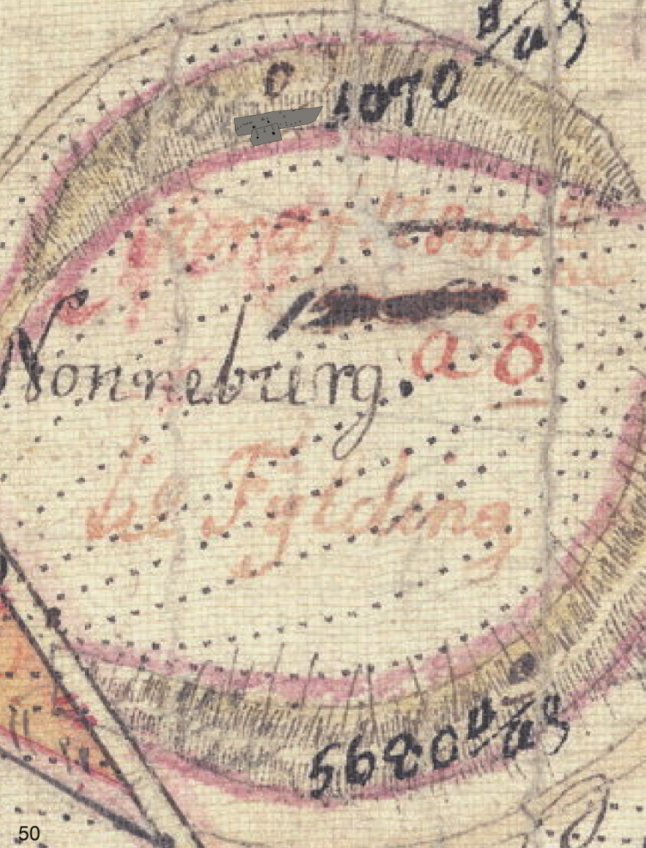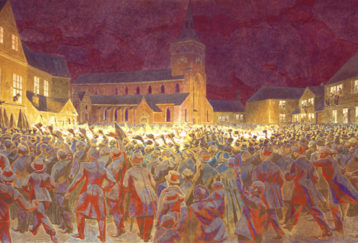
Much of the special appeal of Hans Christian Andersen’s tale Grantræet (“The Fir Tree”) lies in the way in which the author recounts the life history of a Christmas tree as if seen from within. From beginning to end, the tree itself is the central intelligence which observes, reflects, feels pleasure or pain, and speaks. All the events of the tale are presented as if seen from the tree’s own point of view. Although the tree is utterly powerless to shape its own fate – and from this powerlessness derives much of the bite of the story’s irony – the same tree is capable of reflecting on its fate in words which often are charged with emotion. What the tree sees and hears is the substance of the story. What the tree feels emotionally is what makes the story memorable, as memorable to readers throughout the world today as it was to the citizens of Denmark who read it so eagerly when it was published in Andersen’s Nye Eventyr, anden Samling shortly before Christmas, 1844.
Trees which talk and which are endowed with human sentiments are a commonplace of folktales,[1] and it is natural to think that the central idea for Grantræet came to Andersen as a fruit of his wide reading in popular literature. All the same, no folktale source of or analogue to the tale has yet been claimed, as far as I know. Furthermore, Andersen’s fir tree differs markedly from the sentient trees of folktales in that far from having only an incidental role to play, Andersen’s tree is the sole protagonist of the tale. Whereas the talking trees of folk literature tend to be encountered casually in the course of a hero’s adventures and tend to drop from the story once their part is played, Andersen’s tree remains at the center of our attention from beginning to end. At first we see it growing year by year in the forest; then we see it chopped down and dragged to market for sale; then we see it set up in a living room as a fully ornamented Christmas tree. After this brillant epiphany it is taken to a loft and discarded, and in the end it becomes fuel for a bonfire. Like Andersen’s Steadfast Tin Soldier – a hero with whom it has much in common – the tree suffers the pangs of desire for a condition of happiness which it never can attain, a desire which ends only when the sufferer is consumed in flames.
Despite the absence of specific folktale analogues to Grantræet, I would suggest that there does exist a literary context for the tale. In a recent article appearing in Neuphilologische Mitteilungen titled “Oral Theme and Written Texts,”[2] Alain Renoir calls attention to a theme common to a number of works of archaic literature, a theme which for the sake of convenience we might call “The Wooden Object Which Speaks.” To simplify Renoir’s description somewhat, we might characterize the theme as follows.[3] An elongated, man-made, wooden object of any size (a boat, a cross, a rune-stick) speaks up to tell how it once had a previous existence under the form of one or more live trees. The three clearest examples of the theme which are cited by Renoir are Catullus’ Carmina 4 ( Phasellus ille), in which Catullus’ boat tells of its former life as living wood on a mountain top; the Anglo-Saxon poem known as The Husband’s Message, in which certain rune-sticks tell how they once were part of a living tree; and the Anglo-Saxon poem known as The Dream of the Rood, in which the Holy Cross relates its own life history from the time that it lived as a tree in the forest, to the time that it was cut down and was reared up as a gallows for the Crucifixion, to the later time when it came to be venerated as the Rood which points Christians the way toward salvation. Renoir cites analogues to the theme from the Iliad, I: 232-243 (the genealogy of Achilles’ scepter) and from the Aeneid, XII: 202-211 (the genealogy of Latinus’ scepter). In neither of these analogues does the object actually speak, however.
Andersen’s Grantræet accords closely enough with the paradigm of the theme of “The Wooden Objects Which Speaks,” it seems to me, for his tale to be considered a fourth clear example of the theme.[4] In this case the tree is not the sole narrator of its own story, of course: Andersen recounts the life history of the tree by means of third-person narrative, while at different moments the tree itself simply calls to mind scenes from its prior life in a forest, or in a living room at Christmas, or in a loft surrounded by curious mice. In Andersen’s tale as in the other chief examples of the theme, still, we meet with a sentient wooden object (the Christmas tree) which speaks of its prior life as a living tree. If Renoir is correct in his supposition that the theme of “The Wooden Object Which Speaks” originally was an oral-formulaic theme and that its appearance in the works of Catullus and the Anglo-Saxon poets is an example of oral-formulaic theme survival, then there seems to be no reason to conclude that Andersen consciously was aware of this archaic theme or that he consciously modelled his tale upon one of these prior poems. Although echoes of classical and medieval antiquity may possibly have been in his mind on December 6, 1844, when he was composing the tale, on the whole it seems safer to conclude that Andersen was drawing independently from the raw materials of oral tradition and from the resources of his own imagination.
Beyond the general similarity of Grantræet and the theme of “The Wooden Object Which Speaks,” all the same, there exists an affinity between Andersen’s tale and the Anglo-Saxon poem The Dream of the Rood which I would like to explore at greater length.[5] In each of these two works, the sentient wooden object which speaks is a tree which has been cut down in the woods, cut down to play a chief role in an event or in a festival of outstanding importance in the Christian liturgical year. We might note the following additional points of resemblance between the two works (which I shall abbreviate Gr and DrR). (1) The tree is ignorant of its own fate as well as of the motives of those who cut it down. (2) After having been dragged from the forest, the tree is set up among men as an awesome or as a glorious spectacle. (3) This spectacle has to do with a critical event from the life of Christ: the Crucifixion (DrR) or the Nativity (Gr). (4) Either at this time or before, the tree physically suffers. It is wounded with dark nails (DrR), or it feels sharp pain at the blows of an axe (Gr). (5) Either at this time or later, the tree is wondrously adorned. It is covered with jewels (DrR), or it is decked with ornaments (Gr). (6) After its ritualistic function is fulfilled, the tree is discarded in a place where it is hidden from the eyes of men. It is buried in the ground (DrR), or it is hidden in a dark loft (Gr). (7) After a lapse of time, the discarded tree again comes to the light. It is unearthed by followers of Christ (DrR), or it is brought out into an open courtyard (Gr). (8) To conclude its life history, the tree undergoes a final transformation, a transformation which represents an ironic reversal of its previous expectations. It is made into an object of veneration (DrR), or it is completely consumed by fire (Gr).
Once we have taken stock of these parallels, we should hasten to note also some of the striking points of difference between the two works. The Dream of the Rood is a highly imaginative meditation on the subject of the most important event of world history since the Fall, namely the Redemption of Mankind by Christ. The poem is constructed as a complex narrative in which the central speech of the Rood takes the form of a dream-vision, a vision which is framed by an introductory passage (1-27) and a concluding passage (122-156) which tell of the experience and the hopes of the human dreamer. By comparison, Andersen’s story seems a charming if melancholy divertissement. Its narrative movement seems almost childlike in its simplicity. All the same, Andersen’s tale too has its moral meaning. The person who reviewed the tale in Nyt Aftenblad (3 January 1845) as “mere en Fabel af moralsk og temmelig trist Indhold, end et sandt Eventyr”[6] put the matter well: the tale is intended to light the way toward human wisdom by recounting a fable of human folly. Both Andersen’s sad fable and the Anglo-Saxon visionary poem are meant to teach a lesson. Whereas the medieval poem preaches a vision of the heavenly bliss which awaits the faithful servants of the Lord, however, the modern story tells only of the repeated disappointment and ultimate destruction of a being which once was a thing of beauty and grace, but which was not content to enjoy its free and open life in nature.
Also common to the two works is an essential similarity between the situation of the narrator/author and the situation of the tree. Although nothing is known of the identity of the author of The Dream of the Rood, from internal evidence we may conclude that he was almost certainly an ecclesiastic, a man set apart from other men (as the Rood was set apart from other trees) by virtue of his special relationship to the Christian Savior. Like the Cross, he feels himself physically wounded (forwundod mid wommum, 14a). Yet also like the Cross, he looks forward to being raised up eventually into the glory of the Son. In similar fashion, Andersen’s fir tree seems an extension of the author’s own hopes and fears. The tree’s sufferings seem to have no end. Although the tree has hopes of winning a princess, like the Klumpe-Dumpe of the tale told round the Christmas tree, the reader knows that these hopes are vain. Like Andersen, the tree is destined to a life of essential solitude. Also evident in the tale is a concern with the process of aging.
Andersen was thirty-nine years old when he wrote Grantræet. His tree clings fiercely to its youth. When the little mice address the fir tree as “Du gamle Grantræ,” the tree replies indignantly, “Jeg er slet ikke gammel; . . . jeg er i min allerbedste Alder!” Finally – and here the resemblance between narrator and protagonist is perhaps most striking — the fir tree is a storyteller who takes keen delight in the presence of a circle of spellbound listeners. As the tree itself confesses in a moment of nostalgia, “Det var dog ganske rart, da de sad omkring mig de vevre Smaamuus og hørte, hvad jeg fortalte!”
Specific linguistic parallels between the two works are scarcely to be expected. One therefore is surprised to note that both the Danish and the English author make repeated use of the same etymologically-related word, the verb bæve or bifian (“to tremble”). The word recurs so frequently in Andersen’s tale as to be almost a leit-motif. We first meet with it when the tree is standing in the forest listening to a flock of sparrows tell of a Christmas tree which they have seen in town:
„Og saa-?“ spurgte Grantræet og bævede i alle Grene. „Og saa? Hvad skeer saa?“
The word is used for the second time when the fir tree is chopped down and is brought into a living room to serve as a Christmas tree:
Og Grantræet blev reist op i en stor Fjerding, fyldt med Sand, men Ingen kunde see, at det var en Fjerding, thi der blev hængt grønt Tøi rundt om, og den stod paa et stort, broget Tæppe. O, hvor Træet bævede!
The same word appears again when the candles adorning the tree are lit:
Nu bleve Lysene tændte, Hvilken Glands, hvilken Pragt, Træet bævede i alle Grene derved, saa at et af Lysene stak Ild i det Grønne; det sved ordenligt.
And the word is used a last time when the fire which threatens the tree from the burning candles is quenched. Now the tree knows that it must stand still:
Nu turde Træet ikke engang bæve.
In The Dream of the Rood, the Old English equivalent of the same verb appears twice. First it is used to describe the shaking of the earth which precedes the Crucifixion:
þær ic þa ne dorste ofer dryhtnes word bugan oððe berstan, þa ic bifian geseah eorðan sceatas.
(35-37a)[There, then, I durst not bow or break against the Lord’s command when I saw the surface of the earth trembling.]
Second, the word is used to describe the physical shaking of the Cross when Christ is stretched upon it:
Bifode ic þa me se beorn ymbclypte. Ne dorste ic hvæðre bugan to eorðan, feallan to foldan sceatum, ac ic sceolde fæste standan.
(42-43)[I trembled when the man embraced me; however, I durst not bow to earth, fall to the surface of the ground, but I had to stand fast.]
These specific verbal parallels, added to the similarities already noted, lead one to suspect that the relationship between Grantræet and The Dream of the Rood may be closer than one would think at first. Did Andersen then know any Old English? Did he model his story upon what he may have read or may have heard about this Anglo-Saxon poem?
Probably not. The prominent appearance of the verb bæve/bifian in the two works is due probably to mere chance and to a similarity in subject-matter. Most likely Andersen knew as little about Anglo-Saxon literature as did most other Europeans of his time: that is, next to nothing. The possibility that Andersen knew something of The Dream of the Rood at the time when he was composing Grantræet is a remote one, given the history of publication of the earlier work. The Dream of the Rood occupies folios 104b-106a of the codex known as the Vercelli Book, a tenth century Anglo-Saxon manuscript housed in the chapter library of the cathedral at Vercelli, Italy. Virtually nothing was known of the contents of the codex until 1833, when Benjamin Thorpe printed an edition of the manuscript as Appendix B to A Report on Thomas Rymer’s Foedera (pp. 47-138). Publication of the edition was delayed until 1869, however, and in the intervening years the contents of the Vercelli Book were known only to a few pioneering students of Germanistik. One of these few was the Englishman John M. Kemble, who issued his own edition of the manuscript (with modern English translations) in two parts in London in 1843 and 1856. As The Dream of the Rood appeared in the second of these two parts, Andersen could not have known it directly. Somewhat earlier, however, Jacob Grimm had issued an independent edition of two different poems from the Vercelli Book (Andreas and Elene, Cassell, 1840). Since Grimm’s edition was based on Thorpe’s Appendix B, one may presume that by 1840 Grimm had studied The Dream of the Rood as well. If so, Grimm’s interest in the poem must have been quickened late in 1842, when Kemble wrote him informing him of a close connection between the manuscript poem The Dream of the Rood and a set of runic inscriptions on the early Northumbrian monument known as the Ruthwell Cross:
Tell Wilhelm [Grimm] of the following pretty little discovery of mine: the fifth poem in the Vercelli book is called by Thorpe “A Dream of the Holy Rood” or Cross. The Cross is supposed to address the sleeper: now the address is merely an inscription and contains slightly varied all that I recovered of the Ruthwell inscription: I had read it nearly all accurately. . . . What a pity it is to think how much must have been lost! The poem contains nearly 200 lines, the cross has hardly 20![7]
When Andersen and Grimm exchanged visits in the summer of 1844, then, first in Berlin and then in Copenhagen – only a few months before Andersen wrote Grantræet – we may be sure that Grimm was familiar with at least the basic story of The Dream of the Rood. During either meeting, did the famed German scholar and the younger Danish storyteller exhange words on the subject of speaking trees? According to Andersen’s account of the two meetings, no.[8] Each conversation would have been too brief for the exchange of more than greetings. From the first meeting Andersen fled in a state of acute embarassment and chagrin when he discovered that his name and fame had never reached Grimm’s ears.[9] At the time of the second meeting, Andersen was rushing to pack his valise in time to catch a ferry for the provinces, and the encounter seems to have been equally brief. Later, to be sure, Andersen and the Grimms came to deepen their acquaintance. By 1846 Andersen writes of his having come to know both brothers “like old companions”: “Jeg saae næsten daglig begge disse to begavede, elskelige Brødre; de Kredse hvor jeg indbødes, syntes ogsaa at være deres.”[10] Still later Andersen developed a keen interest in Germanic antiquities, as can be seen from the paraphrases of the Eddie lay Hávamál which enliven his tale DyndKongens Datter (“The Marsh King’s Daughter,” 1858). But in December of 1844, Andersen probably never had heard of the existence of the poem which later came to be known as one of the masterworks of Anglo-Saxon literature.
We may conclude fairly confidently that The Dream of the Rood is best taken as a remarkable analogue to Andersen’s Grantræet rather than as a source for it. Very possibly, in composing the tale Andersen drew on the same oral traditions which Renoir sees as underlying the theme of “The Wooden Object Which Speaks.” Conceivably the tale has no source other than its author’s imagination. In any case, when he turned his genius toward this particular theme, Andersen succeeded in reviving a form of literature with firm roots in Germanic antiquity. For not only The Dream of the Rood and The Husband’s Message, but also a number of Anglo-Saxon riddles of the Exeter Book show this same inverted point of view whereby an inanimate object (a horn, a Biblical codex, mead, malt, a coat of mail, a reed pen, an inkhorn, a spear) is imagined to be telling its own life history.[11] Like the anonymous authors of these poems, Andersen was gifted with a keenly anthropomorphic vision. He saw into the secret life of things. His gift of experiencing the world as it might appear through the imagined eyes of inanimate objects is one of the most characteristic features of his art, and it is apparent in a number of his tales other than Grantræet, perhaps most notably in Den standhaftige Tinsoldat (“The Steadfast Tin Soldier”), in Hyrdinden og Skorstensfeieren (“The Shepherdess and the Sweep”), in Flaskehalsen (“The Bottle Neck”), and in Den gamle Gadelygte (“The Old Street Lamp”). As Julius Bomholt writes, “He made the tatters speak. A rusty darning needle, a collar thrown away into a dustbin, an eggshell floating in the gutter, all these can tell a story which initiates us, too, into life.”[12] Like many a teller of popular folktales and riddles, Andersen seems to have been able to see nature and the domestic world as alive in all its parts. His ability to do so not only shows his affinity with “the folk.” It also reserves him a lasting place in the company of poets and seers.


